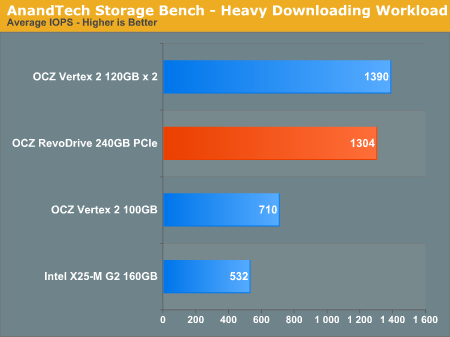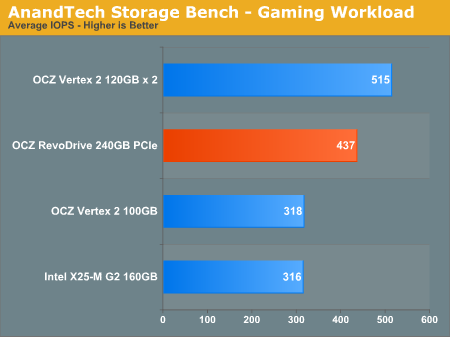OCZ's RevoDrive Preview: An Affordable PCIe SSD
by Anand Lal Shimpi on June 25, 2010 2:15 AM ESTAnandTech Storage Bench
The first in our benchmark suite is a light usage case. The Windows 7 system is loaded with Firefox, Office 2007 and Adobe Reader among other applications. With Firefox we browse web pages like Facebook, AnandTech, Digg and other sites. Outlook is also running and we use it to check emails, create and send a message with a PDF attachment. Adobe Reader is used to view some PDFs. Excel 2007 is used to create a spreadsheet, graphs and save the document. The same goes for Word 2007. We open and step through a presentation in PowerPoint 2007 received as an email attachment before saving it to the desktop. Finally we watch a bit of a Firefly episode in Windows Media Player 11.
There’s some level of multitasking going on here but it’s not unreasonable by any means. Generally the application tasks proceed linearly, with the exception of things like web browsing which may happen in between one of the other tasks.
The recording is played back on all of our drives here today. Remember that we’re isolating disk performance, all we’re doing is playing back every single disk access that happened in that ~5 minute period of usage. The light workload is composed of 37,501 reads and 20,268 writes. Over 30% of the IOs are 4KB, 11% are 16KB, 22% are 32KB and approximately 13% are 64KB in size. Less than 30% of the operations are absolutely sequential in nature. Average queue depth is 6.09 IOs.
The performance results are reported in average I/O Operations per Second (IOPS):

The OCZ RevoDrive does very well in our light usage case, but it does echo what we saw in the PCMark results. The performance benefit here is 27% however that’s purely I/O. Taken in the context of the real world with CPU and other bottlenecks you’re probably looking at a 7 - 15% performance advantage. Thankfully the RevoDrive doesn’t come with a high premium, making the added performance very cost effective.
If there’s a light usage case there’s bound to be a heavy one. In this test we have Microsoft Security Essentials running in the background with real time virus scanning enabled. We also perform a quick scan in the middle of the test. Firefox, Outlook, Excel, Word and Powerpoint are all used the same as they were in the light test. We add Photoshop CS4 to the mix, opening a bunch of 12MP images, editing them, then saving them as highly compressed JPGs for web publishing. Windows 7’s picture viewer is used to view a bunch of pictures on the hard drive. We use 7-zip to create and extract .7z archives. Downloading is also prominently featured in our heavy test; we download large files from the Internet during portions of the benchmark, as well as use uTorrent to grab a couple of torrents. Some of the applications in use are installed during the benchmark, Windows updates are also installed. Towards the end of the test we launch World of Warcraft, play for a few minutes, then delete the folder. This test also takes into account all of the disk accesses that happen while the OS is booting.
The benchmark is 22 minutes long and it consists of 128,895 read operations and 72,411 write operations. Roughly 44% of all IOs were sequential. Approximately 30% of all accesses were 4KB in size, 12% were 16KB in size, 14% were 32KB and 20% were 64KB. Average queue depth was 3.59.

Our heavy test shows the RevoDrive nearly doubles the performance of a single OCZ Vertex 2.
The gaming workload is made up of 75,206 read operations and only 4,592 write operations. Only 20% of the accesses are 4KB in size, nearly 40% are 64KB and 20% are 32KB. A whopping 69% of the IOs are sequential, meaning this is predominantly a sequential read benchmark. The average queue depth is 7.76 IOs.

Our gaming workload also improves a bit as well. This thing is quick. A pair of Vertex 2s in RAID are still faster thanks to Intel's controller.










62 Comments
View All Comments
Demon-Xanth - Friday, June 25, 2010 - link
That connector is called a MICTOR (not sure on the spelling). It's made to hook a logic analyzer up to and generally not useful for most people.Trisagion - Saturday, June 26, 2010 - link
Doesn't look like a MICTOR to me. A MICTOR has contacts aligned along the center, this one has contacts that are on aligned on opposite sides along the center.flgt - Saturday, June 26, 2010 - link
It looks like the Samtec version of the MICTOR. QSH series maybe. Same concept though. High speed, impedance controlled debug or board-to-board connector.Trisagion - Sunday, June 27, 2010 - link
Yes, I think you're right. Thanks!mrmike_1949 - Friday, June 25, 2010 - link
whenever you test ssd, you should still include a fast hdd as a reference point!mckirkus - Friday, June 25, 2010 - link
Seconded. A VRaptor would have been a good idea. Also, can you RAID two of these like SLI vid cards?Intel clearly has RAID figured out. I'm guessing they're going to drop their on version of this thing in Q4 with 22nm flash and blow everybody else out of the water. I also wonder what the latency is like going through all of those bridges and controllers. PCI-e is supposed to be lower latency than SATA right?
Voo - Saturday, June 26, 2010 - link
The problem with that is, that even the fastest 15k rpm SCSI drive would still be nothing more than a bar in most benchmarks, so not really that usefull and if you're interested in it you could always use bench.Though you have a point that it'd be a helpful reminder of the huge difference between HHDs and SSDs and would show that the differences even between the fastest/slowest SSDs aren't that important if compared to HDDs.
chemist1 - Friday, June 25, 2010 - link
OK, when can they shrink one of these onto an express card, so I can plug it into the PCIe slot on my early-2008 MacBook Pro (whose SATA interface is limited to 150 MB/s)?aya2work - Friday, June 25, 2010 - link
Anand,Your storage bench are very interesting and looks like most adequate storage test. Do you have any plans to make it available for other users? (for personal use)
ps: sorry for poor English
Breit - Friday, June 25, 2010 - link
Is it possible to change the stripe size on the RevoDrive's internal RAID-0 in the SI BIOS? I did a little research myself regarding stripe sizes in SSD-RAID-0's and found that a 16kb stripe size is ideal for overall performance instead of the default 64kb (at least on Intel ICH10-R). With that configured a Vertex LE RAID-0 (x2) could easily come from around 40K to 80-90K in the Vantage HDD Suite.